[1]
P. M. Natishan and W. E. O'Grady, Chloride ion interactions with oxide-covered aluminum leading to pitting corrosion: A review, J. Electrochem. Soc. 161 (9) (2014) C421-C432.
DOI: 10.1149/2.1011409jes
Google Scholar
[2]
T. J. Grassman, G. C. Poon and A. C. Kummel, Low coverage spontaneous etching and hyperthermal desorption of aluminum chlorides from Cl2/Al(111), J. Chem. Phys. 121 (2004) 9018.
DOI: 10.1063/1.1805495
Google Scholar
[3]
B. E. Blöchl, Projector augumented-wave method, Phys. Rev. B 50 (1994) 17953.
Google Scholar
[4]
P. Giannozzi, S. Baroni, N. Bonini, M. Calandra, R. Car, C. Cavazzoni, D. Ceresoli, G. L. Chiarotti, M. Cococcioni, I. Dabo, A. Dal Corso, S. Fabris, G. Fratesi, S. de Gironcoli, R. Gebauer, U. Gerstmann, C. Gougoussis, A. Kokalj, M. Lazzeri, L. Martin-Samos, N. Marzari, F. Mauri, R. Mazzarello, S. Paolini, A. Pasquarello, L. Paulatto, C. Sbraccia, S. Scandolo, G. Sclauzero, A. P. Seitsonen, A. Smogunov, P. Umari, R. M. Wentzcovitch, J. Phys. Condens. Matter 21 (2009).
DOI: 10.1088/0953-8984/21/39/395502
Google Scholar
[5]
J. P. Perdew, K. Burke, and M. Ernzerhof, Generalized gradient approximation made simple, Phys. Rev. Lett. 77 (1996) 3865l.
DOI: 10.1103/physrevlett.77.3865
Google Scholar
[6]
M. Methfessel and A.T. Paxton, High-precision sampling for Brillouin-zone integration in metals, Phys. Rev. B 40 (1989) 3616.
DOI: 10.1103/physrevb.40.3616
Google Scholar
[7]
A. Kokalj, Computer graphics and graphical user interfaces as tools in simulations of matter at the atomic scale, Comp. Mater. Sci. (2003) 28, 155 (Code available from http: /www. xcrysden. org/).
DOI: 10.1016/s0927-0256(03)00104-6
Google Scholar
[8]
R. Gaudoin and W. M. C. Foulkes, Ab initio calculations of bulk moduli and comparison with experiment, Phys. Rev. B 66 (2002) 052104.
DOI: 10.1103/physrevb.66.052104
Google Scholar
[9]
D. R. Lide, CRC Handbook of Chemistry and Physics, 74th ed., CRC Press, Boca Raton, FL, (1993).
Google Scholar
[10]
A. Kiejna and B. I. Lundqvist, First-principles study of surface and subsurface O structures at Al(111), Phys. Rev. B 63 (2001) 085405.
DOI: 10.1103/physrevb.64.049901
Google Scholar
[11]
K. Mitsutake, J. Yamauchi, A. Sakai and M. Tsukada, Theoretical study of dissociative adsorption of Cl2 on the Al surface, Surf. Sci. 324 (1995) 106-112.
DOI: 10.1016/0039-6028(94)00707-1
Google Scholar



